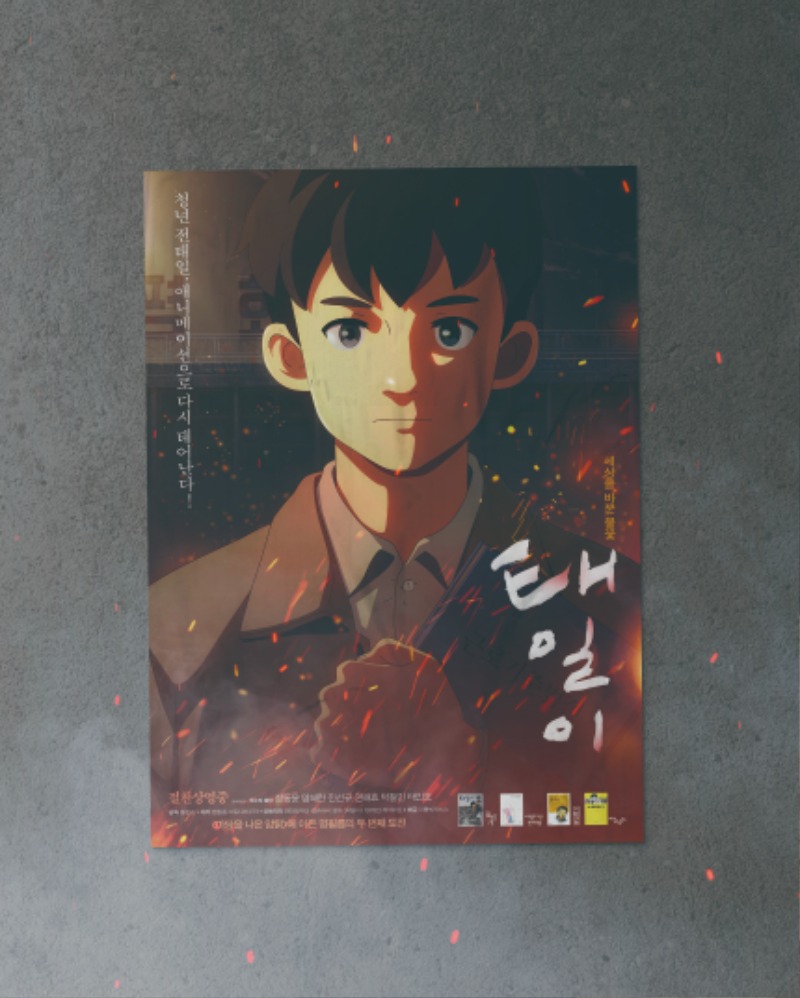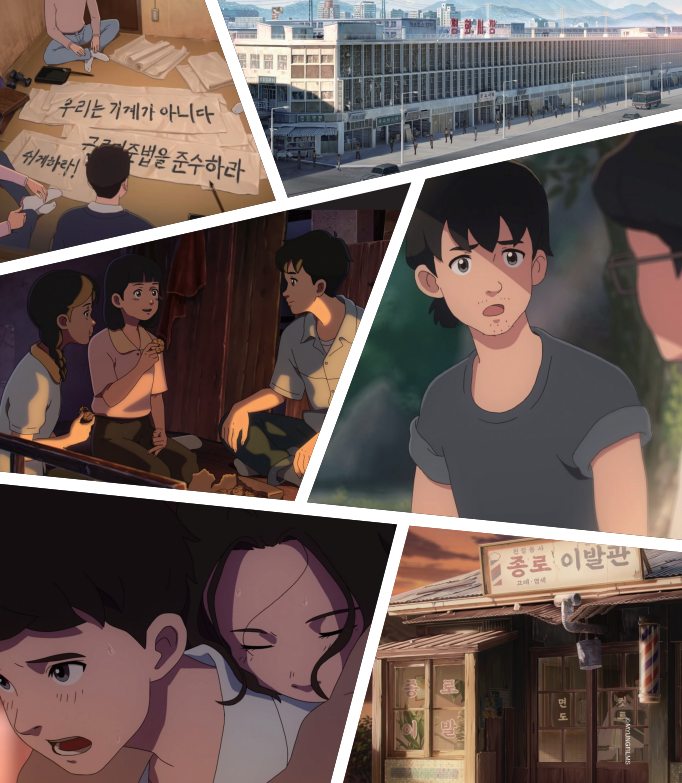Award-winning “Chun Tae-il: A Flame That Lives On” is a biographical animated film about a 22-year-old activist who sacrificed his life fighting for workers’ rights. The particular labor issues of his time are less pertinent today, but not the film’s depiction of discrimination and inequality.

“Chun Tae-il: A Flame That Lives On” (2021) is an animated film that tells the real-life story of a young sweatshop worker who sacrificed himself to improve working conditions and protect the rights of laborers.
ⓒ MYUNGFILMS
To escape poverty, Korea pursued economic growth by exploiting workers in the 1960s and 1970s. Sweatshops were widespread, and although the Labor Standards Act had been legislated, enforcement of labor regulations took a back seat to economic growth.
Recipient of the Contrechamp Jury Distinction prize at the 46th Annecy International Animated Film Festival in 2022, the Audience Award (Bronze Award) at the 26th Fantasia International Film Festival for Best Animated Feature, and the Grand Prize at the 18th Seoul Indie-AniFest, “Chun Tae-il: A Flame That Lives On” is creating a buzz with its depiction of a young man who became a martyr of the Korean labor movement.
GRINDING SWEATSHOPS

The film does not only focus on Chun Tae-il’s legacy as a martyr who fought against inhumane working conditions and meager pay in sweatshops. It also illuminates his childhood, hopes and dreams of first love.
ⓒ MYUNGFILMS
The workers often suffered from various illnesses, including lung disease from the dust particles produced in fabric processing, but they were fired immediately if they dared to take a sick day. Those who remained could only look forward to a salary that barely kept them fed.
Born to an impoverished family in Daegu, Chun Tae-il had to quit school to help support his family. He eventually left for Seoul and became a tailor’s assistant, applying sewing skills that he had learned at home. Chun cared for the young sewers as if they were his sisters, using his bus fare to buy cheap bread for them. Horrified at their working conditions, he gathered his co-workers to form labor groups. He informed them of their rights and constantly badgered apathetic officials to enforce regulations on working conditions.
The workers staged protests, but every time they were disbanded by police. Then, on November 13, 1970, when another protest was stopped in front of Pyeonghwa Market, Chun held up a copy of the Labor Standards Act and shouted, “Comply with the Labor Standards Act; we are not machines.” Then he set himself on fire. He was rushed to the hospital but succumbed to his severe burns. Before passing away, he said, “Do not let my death be in vain.”
THOUGHTFUL BACKSTORY
Hong Jun-pyo, the director of the film, deliberately stepped away from the iconic martyr image of Chun Tae-il. “Jeon,” the usual spelling of the activist’s surname, was not used and he is not depicted as a one-dimensional hero.
The animation depicts Chun as a young man and delicately describes his feelings of love in 1967 based on his diary, most of which is preserved to this day. He fell in love with his boss’s sister-in-law, but his love was unrequited and he abandoned hope. Chun realized that if his boss were to dislike him, his life in their hierarchical sewing factory could become even more miserable. His decision reflected awareness of the harsh realities that he faced. It is a pivotal moment; the concept of social class becomes even more embedded. Chun is no longer caught up with simply personal matters, and the film goes to great lengths to capture this point.
Especially noteworthy is how the film traces Chun’s thoughts as his awareness of social division deepens. One of the sequences shows him staying at his boss’s house and noticing how the soap smells different from his soap at home. The depiction of classes divided by smell is an important motif that also appears in director Bong Joon-ho’s highly acclaimed film “Parasite.” Today’s audiences, living in societies with extreme inequality, can all sympathize.
NO DIFFERENT TODAY
“Chun Tae-il: A Flame That Lives On” does not let a decades-old event stand alone. It extracts relevance in today’s world. The wage distribution conflict and the exploitative structure that existed in Seoul’s garment district in the 1960s are re-examined through the lens of tension between laborers rather than labor vs. management conflicts.
Management promoted this dynamic through a rigid hierarchy. From top to bottom, the hierarchy was tailor, tailor’s assistants, sewers, and sewer’s assistants. A worker supervised each of the sub-groups, not someone from management ranks. The boss did not fire workers – that was the job of the tailor. Another common practice was to have the tailor make salary decisions, thus removing direct friction between the employer and the workforce.
Today, labor decisions are handled similarly. The person with ultimate responsibility and authority avoids conflict by having middle management held accountable instead, thereby trying to disguise problems. For example, by framing demands for a minimum wage as an issue between franchisees and part-timers, the heads of large corporations can stay out of the debate and not address the crux of the problem.
Even though “Chun Tae-il: A Flame That Lives On” is set in a different era, today’s audiences can relate to the treatment of the most vulnerable. In Korea, there are s and s of subcontractors, and the economic system mass-produces platform workers and specially hired workers who do not even have contract protection.
This problem is not limited to Korea. “Two Days, One Night,” directed by the Belgian Dardenne brothers, “Sorry We Missed You,” directed by Ken Loach, and Eric Gravel’s “Full Time,” one of this year’s most talked-about films, all show what our societies are turning into. New types of employment in global capitalism or conflicts among workers play out in an unprecedented way, which allow the strong ps to evade responsibility and the weak ones to fall behind even further.
“Chun Tae-il: A Flame That Lives On” is up there with all the other masterpieces, presenting the complex labor challenges that we face today in a straightforward way by using a story dating back more than 50 years.
Toward the end of the movie, when Chun Tae-il self-immolates, the film does not dwell on the scene. Instead, the camera lingers on the surprised looks of his colleagues and bystanders.
Their facial s are our own, and the following questions are thrown at us: Who d the social conflict that you are witnessing now? Where did the social misfortune you see now come from? What disasters are unraveling before you now and what actions are you taking? “Chun Tae-il: A Flame That Lives On” tells us that to find the answers to the questions, we first need to take a closer look at ourselves.